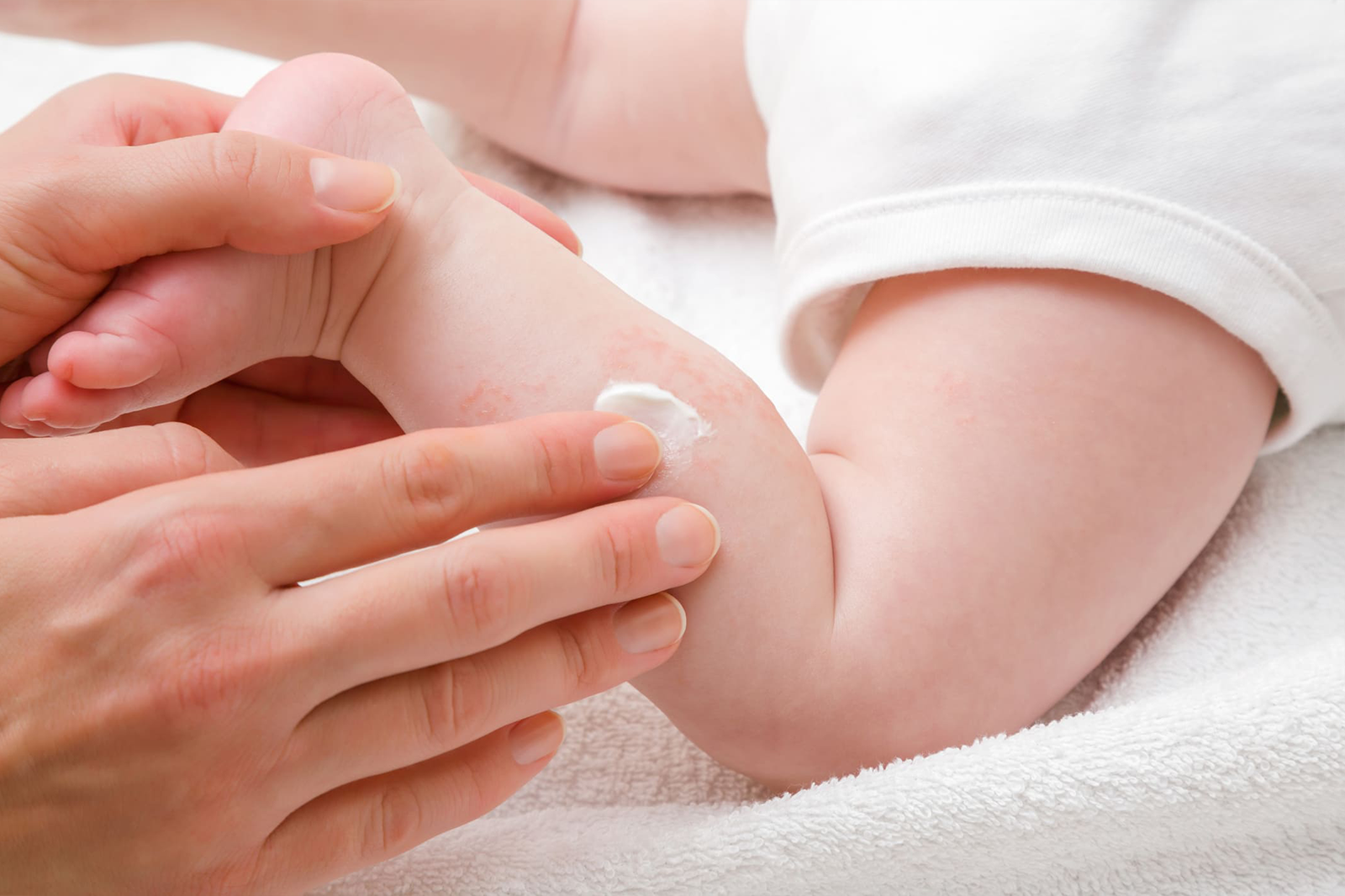Newborn babies have different skin from adults, so having a firstborn can be a challenge when trying to decide which cosmetics to use on your little ones.
When a baby is born, its skin barrier adapts to the dry environment quite quickly, but the development of this protective barrier continues for several years. The outer (stratum corneum) layer of the epidermis is responsible for retaining water in the skin and protecting the deeper layers of the skin from the ingress of hazardous substances [1], but this layer is thinner in babies than in adults. It has also been observed that the concentration of natural moisturising factors (NDFs), which act as humectants in the stratum corneum, is lower in the skin of toddlers than in adults [2]. For these reasons, babies’ skin absorbs water more quickly, but also loses water more quickly and is prone to various types of dermatitis.
It has become commonplace to use a variety of cosmetic products to protect and strengthen baby’s skin, but with so many of them available, it can be difficult to choose the right products. There are a few key ingredients that are the most nourishing to the skin and should be looked for on the labels of children’s cosmetics.

The difference between adult and baby skin/ Photo. from eltean.com
Emollients are a type of cosmetic ingredient that includes raw materials such as oils, waxes, fats and petroleum jelly. Emollients are a safe and effective way to reinforce the skin barrier by providing dry baby skin with lipids that improve its barrier properties [3].
One of the most useful emollients in cosmetic products is jojoba oil(Simmondsia Chinensis Seed Oil), which is rich in vitamins A, D, E, antioxidants and essential fatty acids. It nourishes and nourishes the skin, and can also help with skin problems such as eczema and rashes. Because it is rich in ceramides, it can also strengthen the skin barrier and, as it strengthens, the skin will be able to retain moisture for longer.
Another useful ingredient to fight dryness in babies is CocosNucifera Oil, which has anti-inflammatory and antimicrobial properties due to its high concentration of lauric acid [4]. The linoleic acid in the oil stimulates cell renewal, helps strengthen the skin barrier, retains moisture in the skin, and helps soften and smooth it. The oil forms a protective, waterproof layer on the skin, reducing transepidermal water loss.
Sweet almond oil(Prunus Amygdalus Dulcis Oil) is also often found in cosmetics for dry baby skin. Sweet almond oil contains as much as 60% oleic acid [5], also known as omega-9, which helps maintain moisture levels in the dermis and improves skin elasticity. It also contains squalene, which is a component of our protective skin barrier. The oil’s beta-sitosterol soothes and moisturises the skin, vitamin A is anti-inflammatory and promotes skin regeneration, and vitamin E protects the skin from external aggressors.
Shea butter(Butyrospermum Parkii (Shea) Butter) has a very low content of proteins that can cause allergies, and there are no reported cases of skin allergy to this ingredient in the scientific literature [6]. Thanks to the oleic and stearic acids in butter, it has anti-inflammatory properties and can restore the skin’s lipid barrier, which prevents moisture from evaporating.
Another ingredient that combats dryness in babies’ skin and is worth mentioning is petroleum jelly(Petrolatum). It is one of the best ingredients on the market to help retain moisture in the skin, reducing transepidermal water loss by up to 99%. Although this emollient is derived from petroleum, it is not to be feared – it is an extremely inert substance that does not undergo any chemical changes in the skin, which is why petroleum jelly is considered to be a hypoallergenic ingredient[7]. Moreover, this substance is considered non-comedogenic.
Article author Goda Jašinskaitė, chemist
List of References
1. Wertz PW. Stratum corneum Lipids and Water. Exog Dermatology [Internet]. Karger Publishers; 2004 [cited 2023 Mar 31];3:53-6. Available from: https://www.karger.com/Article/FullText/86155
2. (PDF) Designing cleansers for the unique needs of baby skin [Internet]. [cited 2023 Mar 31]. Available from: https://www.researchgate.net/publication/257341452_Designing_cleansers_for_the_unique_needs_of_baby_skin
3. Simpson EL, Chalmers JR, Hanifin JM, Thomas KS, Cork MJ, McLean WHI, et al. Emollient enhancement of the skin barrier from birth offers effective atopic dermatitis prevention. J Allergy Clin Immunol [Internet]. Elsevier; 2014 [cited 2023 Mar 31];134:818. Available from: /pmc/articles/PMC4180007/
4. Intahphuak S, Khonsung P, Panthong A. Anti-inflammatory, analgesic, and antipyretic activities of virgin coconut oil. http://dx.doi.org/103109/13880200903062614 [Internet]. Taylor & Francis; 2010 [cited 2023 Mar 31];48:151-7. Available from: https://www.tandfonline.com/doi/abs/10.3109/13880200903062614
5. Fernandes GD, Gómez-Coca RB, Pérez-Camino MDC, Moreda W, Barrera-Arellano D. Chemical Characterization of Major and Minor Compounds of Nut Oils: Almond, Hazelnut, and Pecan Nut. J Chem. Hindawi Limited; 2017;2017.
6. Weinberger T, Sicherer S. Current perspectives on tree nut allergy: A review. J Asthma Allergy [Internet]. Dove Medical Press Ltd; 2018 [cited 2023 Apr 1];11:41-51. Available from: https://www.tandfonline.com/action/journalInformation?journalCode=djaa20
7. Draelos ZD. The science behind skin care: Moisturisers. J Cosmet Dermatol [Internet]. John Wiley & Sons, Ltd; 2018 [cited 2023 Apr 1];17:138-44. Available from: https://onlinelibrary.wiley.com/doi/full/10.1111/jocd.12490


